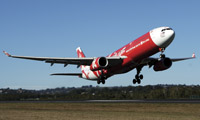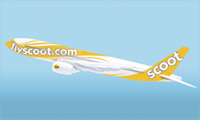Fleet
Capacity crunch fears
The Asia-Pacific airline market continues to outperform other parts of the world, but there is growing unease about the number of new aircraft seats set to enter the region in the next few years.
April 1st 2012
As Asia-Pacific airlines continue to take delivery of new jets in an operating climate marked by its volatility and prospects for 2012 dampened by rising fuel prices and economic uncertainty, they were given another wake-up call during the recent Singapore Air Show. Read More »
 |
| AirAsiaX: redirected its long-haul flights into Asia |
The message: keep a very close watch on capacity growth. Once again the industry may be facing a potential oversupply of airline seats.
The potential for another capacity crunch was a key topic at a low-cost carrier (LCC) Asia Summit on the sidelines of the show, at which aviation think tank, the Centre for Asia Pacific Aviation (CAPA), pointed out that record aircraft deliveries are under way in the region this year despite the well-reported slow growth in traffic.
Carriers in the Asia-Pacific have 520 jets on firm order for delivery in the next three years, including some 120 widebodies. The majority represent additional capacity, not replacement aircraft. It means 15 aircraft deliveries every month, a number that could double if additional leased aircraft were added.
“The upshot of the combination of factors is lower load factors and reduced yields. That in turn implies damage to airlines’ bottom lines in what is now an intensely competitive market, with low-cost airlines, Gulf carriers and Chinese airlines all vying for larger shares of markets that were historically the territory of the region’s flag carriers,” said CAPA.
That view was underpinned by the fact that orders from Asian operators - budget and legacy - dominated the Singapore show. While most of these aircraft won’t arrive for some years, it underscores that there has been no let-up in fleet growth and updating despite the tough economic conditions.
 |
| Scoot: the Singapore Airlines’ subsidiary is one of several new Asia-Pacific carriers set to enter the LCC market |
It is not only the arrival of new aircraft that threatens the capacity situation in the region. Take, for instance, long-haul LCC AirAsia X’s decision to withdraw from Europe and New Zealand. That capacity is being redirected onto routes within Asia.
Add the launch of several new budget operators such as Singapore Airlines’ Scoot, AirAsia Japan, All Nippon Airways’ Peach, Japan Airlines/Qantas’s Jetstar Japan and similar ventures being started by Thai Airways International and Malaysia Airlines and the surge in newly available airline seats on routes across the region becomes evident.
The International Air Transport Association (IATA) reported that Asia-Pacific airlines experienced the widest traffic/capacity gap of all regions in 2011. Traffic rose 4.1% through the 12 months, but capacity climbed 6.4%.
IATA said this trend of surplus capacity will continue in 2012, causing a demand/supply imbalance likely to have a negative impact on load factors and yields and hence profitability. Its latest figures, for January, said Asia-Pacific airlines saw traffic increase 6% in January with capacity, at 6.4%, again outstripping traffic growth.
As a result, the region’s airlines saw load factors drop slightly to 77.5%. But it pointed out that year-on-year traffic growth would have been even softer had it not been for the boost to travel provided by the Chinese New Year.
Industry wide, IATA sees some improvement in the demand/capacity equation. In its latest industry profit forecast last month it said that last December it had expected weaker economic growth to undermine demand faster than airlines would be able to slow down capacity growth.
Now, it says that, judging from airline schedules published for 2012, it underestimated the responsiveness of the industry. “We expect capacity to grow at a slower pace than demand, producing a supply/demand environment that will limit the damage to profitability from high jet fuel prices in our central forecast.”
 |
| 'This is the largest market in the world for single-aisle airplanes, for twin-aisle airplanes and for big airplanes' |
| Randy Tinseth Vice-President Marketing Boeing |
Overall capacity (passenger and cargo) this year is expected to grow 3.2%, which is behind the 3.6% expected expansion in demand. This is a reversal of the expectation in December of 3.1% capacity expansion outstripping 2.9% demand growth.
Nevertheless IATA chief economist, Brian Pearce, said capacity was always a challenging issue. “We are often faced with taking a lot of deliveries when markets slow down. We appear to be facing that situation again,” he said.
“It will be a challenge for airlines to ensure the capacity is fully utilized for the best return on their investment.”
The Association of Asia Pacific Airlines (AAPA) reported airline capacity growth in the region exceeded traffic growth in 2011. International passenger traffic increased 3.7%, but capacity grew 6.3%, which resulted in a two percentage point decline in average international passenger load factor to 76.4%.
For January, the AAPA said international passenger numbers rose 7.3% to 17.2 million compared to the same month last year, again confirming the boost in traffic during the Lunar New Year holiday season.
“In revenue passenger kilometre (RPK) terms, international passenger traffic grew 6.3%. Available seat capacity was up 6.7%, which resulted in a slight 0.2 percentage point fall in the average international passenger load factor to 78.2%,” said the AAPA in its monthly report.
One area of deep concern is the ongoing softness of the cargo market, which has seen some carriers, such as Singapore Airlines, reduce cargo capacity significantly. But increasing numbers of new passenger aircraft automatically introduce more freight capacity into the market and this is capacity which cannot be removed.
These trends have been worrying industry analysts. Head of strategy and market research at Singapore-based lessor BOC Aviation, Peter Negline, writing in IATA’s Analyst Viewpoint, said that globally, single-aisle aircraft deliveries were set to rise by 20% through to 2013.
“More alarmingly, annual widebody aircraft deliveries are due to rise by 91% over the same period, due in part to previous delays in the programmes for the B787, the B747-8 and the A380,” he said.
“Together, this 33% jump in annual production over the three year period equates to an extra 350 aircraft deliveries per year. More worryingly, the growth in production rates does not stop in 2013.”
Negline said some of this growth was being driven by higher fuel prices and environmental challenges, producing a “ferocious appetite for new, fuel efficient aircraft”.
One question that remains is what impact there will be on deliveries this year and next as a result of the current spat between China and Europe over its controversial emissions trading scheme.
Airbus has said this has led to Beijing blocking orders for its aircraft for Chinese airlines. As these are orders and not deliveries the short-term impact should be negligible. And, given the ongoing growth in the Chinese market, it would be reasonable to assume if the Chinese don’t buy their aircraft in Toulouse, they will replace these orders with purchases from Boeing.
According to aviation information group OAG, Chinese carriers are scheduled to receive more than 160 aircraft this year, followed by around 360 aircraft in 2013 and 100 in 2014. China currently has a commercial fleet of 1,719 aircraft, with 663 aircraft on firm order.
According to OAG, at the end of January the total Asia-Pacific fleet stood at 5,436 aircraft, with a further 3,202 on order.
Whatever the short-term potential for overcapacity, there remains no doubt the additional seats will be required in the longer term. The latest market forecasts from both Boeing and Airbus confirm expectations of very strong long-term growth.
Airbus believes airlines in the Asia-Pacific will take delivery of around 9,370 new aircraft valued at $1.3 trillion in the next 20 years, accounting for 34% of all new aircraft with more than 100 seats entering service worldwide.
The European planemaker expects the number of passengers carried by Asia-Pacific airlines to rise by 5.9% annually, compared with the global average of 4.8%. It added that airlines in the region will replace 76% of their current aircraft and by 2030 the overall in-service fleet will comprise some 9,965 passenger aircraft and around 820 freighters.
Boeing expects the Asia-Pacific carriers will require 11,450 new aircraft worth $1.5 trillion by 2030 with 80% for fleet growth. “This is the largest market in the world for single-aisle airplanes, for twin-aisle airplanes and for big airplanes,” said Boeing vice-president marketing, Randy Tinseth.